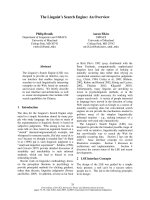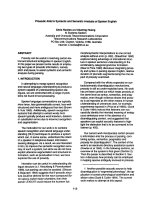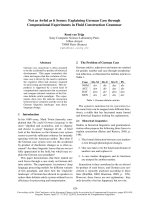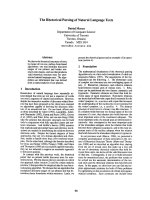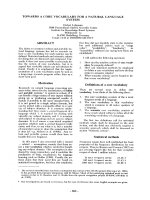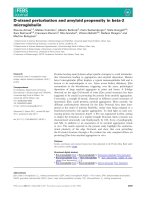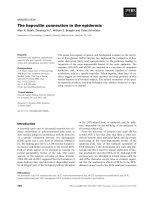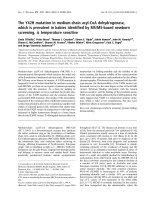Báo cáo khoa học: " THE KEY TO THE SELECTION PROBLEM IN NATURAL LANGUAGE GENERATION" ppt
Bạn đang xem bản rút gọn của tài liệu. Xem và tải ngay bản đầy đủ của tài liệu tại đây (575.72 KB, 7 trang )
SALIENCE: THE KEY TO THE SELECTION PROBLEM IN NATURAL LANGUAGE GENERATION
E. Jeffrey Conklin
David D. McDonald
Department of Computer and Information Science
University of Massachusetts
Amherst,
Massachusetts
01003 USA I
ABSTRACT
We argue that in domains where a strong
notion of salience can be defined, it can be
used to provide: (I) an elegant solution to the
selection problem, i.e. the problem of how to
decide whether a given fact should or should not
be mentioned in the text; and (2) a simple and
direct control framework for the entire deep
generation process, coordinating proposing,
planning, and realization. (Deep generation
involves reasoning about conceptual and
rhetorical facts, as opposed to the narrowly
linguistic reasoning that takes place during
realization.) We report on an empirical study
of salience in pictures of natural scenes, and
its use in a computer program that generates
descriptive paragraphs comparable to those
produced by people.
I. The Selection Problem
At the heart of research on
natural
language generation is the question of how to
decide what to say and, equally important, what
not to say. This is the "selection problem",
and it has been approached in various ways in
the past: Direct translation generators such as
[Swartout 1981, Clancey to appear] avoid the
problem by leaving the decision to the original
designer of the data structures that serve as
the templates to the generator; this places the
burden on that designer to correctly anticipate
what degree of detail and presupposed knowledge
will be appropriate to a specific audience since
on-line adjustments are not possible.
I. This report describes work done in the
Department of Computer and Information Science
at the University of
Massachusetts.
It was
supported in Dart by National Science Foundation
grant IST#8104984 (Michael Aroin and Davis
McDonald, Co-Principal Investigators).
Mann and Moore [1981], on the other hand,
while assembling texts dynamically to suit their
audience, do so by "over-generating" the set of
facts that will be related, and then passing
them all through a special filter, leaving out
those that are judged to be already known to the
audience and letting through those that are new.
McKeown [1981] uses a similar technique her
generator, like Mann and Moore's, must examine
every potentially mentionable object in the
domain data base and make an explicit judgement
as to whether to include it. We argue that in a
task domain where salience information is
available such filters are unnecessary because
we can simply define a cut-off salience level
below which an object is ignored unless
independently required for rhetorical reasons.
The most elaborate and heuristic systems
to date use meta-knowledge about the facts in
the domain and the listener's knowledge of them
to plan utterances to achieve some desired
effect. Cohen [1978] used speech-act theory to
define a space of possible utterances and the
goals they could achieve, which he searched by
using backwards chaining. Appelt [1982] uses a
compiled form of this search procedure which he
encodes using Saccerdotti's procedural nets; he
is able to plan the achievement of multiple
rhetorical goals by looking for opportunities to
"piggyback" additional phrases (sub-plans) into
pending plans for utterances. We argue that in
domains where salience information is already
available, such thorough deliberations are often
unnecessary, and that a straight-forward
enumeration of the domain objects according to
their relative salience, augmented with
additional rhetorical and stylistic information
on a strictly local basis, is sufficient for the
demands of the task.
129
II. Deep Generation and Scene Descriptions
In this paper we present an approach to
deep generation that uses the relative salience
of the objects in the source data base to
control the order and detail of their
presentation in the text. We follow the usual
view that natural language generation is divided
into two interleaved phases: one in which
selection takes place reflecting the speaker's
goals, and the selected material is composed
into a (largely conceptual) ,realization
specification ,,I (abbreviated "r-spec") according
to high-level rhetorical and stylistic
conventions, and a second in which the r-spec is
realized the text actually produced in
accordance with the syntactic and morphological
rules of the language. We call the first phase
"deep generation" instead of the more
specific term "planning" to reflect our view
that its use of actual planning techniques will
be limited when compared to their use in the
generators developed by Cohen, Appelt, or Mann
and Moore.
We are developing our theory of deep
generation in the context of a computer program
that produces simple paragraphs describing
photographs of natural scenes similar to those
analyzed by the UMass VISIONS System [Hanson and
Riseman 1978, Parma 1980]. Our input is a
mock-up of their final analysis of the scene,
including a mock-up annotation of the salience
of all of the objects and their properties as
would be identified by VISIONS; this
representation is expressed in a locally
developed version of KL-ONE. The paragraphs are
realized using MUMBLE [McDonald 1981, 1982],
which is responsible for all low-level
linguistic decisions and for carrying out the
rhetorical directives given in the r-spec.
I. We are introducing this new term
"realization specification" in place of the
term ,,message 'r which had been used in earlier
~
ublications on McDonald's generation sy§tem.
his is a change in name only: these Objects
have the same formal properties as before. The
shift reflects the kind of communication
metaphor on which this work has actually been
based: the old term has often connoted a view of
communication as a process of translating a data
structure in the speaker's head into language
and then reconstructing it in the audience's
head. (the so-called "conduit" metaphor).
Instead, we take it that a speaker has a set of
goals whose realization may entail entirely
d~¢fe-ent utterances depending upon who the
a~dience is and what they already know; that the
speaker's knowledge of their language consist 9
in large part of a catalog of wnat might be saia
and the effects it is likely to have on the
audience; and that, accordingly, language
generation entails a plannin~ process, selecting
among these effects according to the desired
outcome.
As of the beginning of February 1982, the
initial version of the deep generation phase has
been designed and implemented. Figure I shows
the kind of scene we are using in our studies
and an example of the kind of paragraph
description targeted for our system. Efforts to
"This is a picture of a large white house
with a white fence in front of it. In front of
the fence is a cement sculpture. In front of
this is a street, Across the street is a grassy
patch with a white mailbox. There are trees all
around, with one evergreen to the right of the
driveway, which runs next to the house. It is
fall, the sky is overcast, and the ground is
wet."
Figure I. One of the pictd~es used in the
experimental studies with one of the subjects'
descriptions of it. A mocked-up analysis of
this picture was used as the input to the deep
generation process in the example discussed
below.
modify MUMBLE to run in NIL on our VAX are
underway, and we anticipate having an initial
realization dictionary up and the first texts
produced before the end of May. During the
summer and fall of 1981, Jeff Conklin (Conklin
and Ehrlich, in preparation) carried out the
series of psychological experiments discussed
immediately below. The results have been use~
to determine the salience ratings for the
mock-up of the analyzed scenes, and to provide a
corpus of the kinds of texts people actually
produce as descriptions of scenes of suburban
houses.
III. Visual Salience
Our theory of visual salience states that
a given person looking at a given picture in a
given context assigns a salience (an ordering,
rather than a numeric value) to each object as a
130
natural and automatic part of the process of
perceiving and organizing the scene.
Intuitively the salience of an object is based
on its size and centrality (how central it is)
in the image, its degree of unexpectedness, and
its intrinsic appeal or importance to the
viewer.
To substantiate and explore these
intuitions we ran a series of experiments in
which a group of subjects rated the salience of
items in color slides of natural scenes. For
each picture each subject had a form listing all
of the major items in the scene, and their task
was to rate the salience of each item on a zero
to seven scale. In order to define a controlled
context the subjects were asked to imagine that
they worked for a library which had a large
picture section, and that their ranking scores
would be used to Catalog the pictures. The
controlled context is necessary because salience
is generally only defined within a perceptual or
conceptual context there is no salience in a
vacuum. (However, we claim that there is a
default context for viewing pictures which
"anchors" the notion of salience when no other
context is specified: that pictures are taken
for the purpose of showing or telling the viewer
something. While this is not a strong context,
it allows one to talk about visual salience
without precisely defining a purpose for the
viewer.)
In several experiments the subjects were
given a second task: writing a description of
the same pictures for which they were doing the
rating task (one such description appears in
Figure I). In these experiments the series of
pictures was shown twice; in the first viewing,
half of the subjects did the rating task and the
other half did the description task, while in
the second viewing the tasks were reversed, (It
turned out that the description task had no
significant effect on the rating scores.)
Although we are still analyzing the data
from these experiments, _there are several
interesting results. The rating technique is a
fairly stable and consistent non-subjective
measure of salience (when averaging over a
~roup) , and is also quite sensitive to changes
in the size and centrality of objects in the
scene. Figure 2 shows a series of pictures that
were used to determine the affects of size and
centrality. The salience ratings assigned by
subjects to the parking meter in this serAes
were significantly different from each other
(P<.05, as measured by the Wilcoxon rank sum
test). That is, the rating task is sensitive
enough to reveal small changes in the size
and/or centrality of objects in a picture.
Figure 2 A series of views of a parking meter
used to measure the affects of size and
centrality.
131
Also, it was found that salience was a
strong determinant in the order of mention of
objects in the paragraphs. Specifically, the
higher the salience rating given an object by a
subject, the more likely that object was to
appear in the subject's description.
Furthermore, there was a good correlation
between the ranking of the objects (by
decreasing salience) and the order in which the
objects were mentioned in the description.
Interestingly, the exceptions to a perfect
correlation were generally the cases where a low
salience item was "pulled up" into an earlier
position in the text, seemingly for rhetorical
reasons. The explanation that we propose is
that salience is the primary force in selection
in scene descriptions, but that rhetorical
factors can override it (as illustrated below).
IV. An Example
Here is an short example of the kind of
paragraph
which our system currently generates:
"This is a picture of a white
house with a fence in front of it.
The house has a red door and
the
fence has s red gate. Next to the
house is a driveway. In
the
foreground is s mailbox. It is a
cloudy winter day."
This paragraph was generated from a perceptual
representation (in KL-ONE) in which the most
salient objects, in order of decreasing
salience, were:
House, Fence, Door, Driveway, Gate, and Mailbox.
The deep generation component (called GENARO)
maintains this list as the "Unmentioned Salient
Objects List" (USOL), and it is this data
structure which mediates between GENARO and the
domain
data
base (see Figure 3). It should be
stressed that the USOL contains only objects
not properties of objects or relationships
between objects since we specifically claim
that such an "object-driven" approach is not
only more natural but also is adequate to the
task.
There are two "registers" which are used
for focus: "Current-Item" and "Main-Item". The
Current-Item register contains the object
currently in focus (and hence the most salient
object which has not previously been mentioned),
and the Main-Item register points to the data
base's most salient object as the topic of the
entire paragraph (this register is set once at
the beginning of the paragraph generation
process). An object moves into focus by being
"popped" from the USOL and placed in the
DATA
BASE
0
0 0 0 0
0
0 ° 0
USOL
(least
salient)
(most
salient)
$
Rhetorical Rules
(in packets)
Paragraph
~" Driver
[
Proposed
R-Spec Elements i
one
MUMBLE
Figure ~. ~ Liock diagram of the GENARO system. The "O"s
in the "Data Base" represent objects in the domain represen-
tation, whereas the "~"s are the themeatic "shadows" of these
objects used by GENARO for its rhetorical processing. Each
of the ovals in the "Rhetorical Rules" box are packets containing
one or more rhetorical rules.
132
Current-Item register, along with its most
salient properties and relationships (for ease
of access). When formulating the r-spec, most
of the rhetorical rules then look only at the
Current-Item. (Some rules look down "into" the
USOL, or into the r-spec under construction, as
elaborated below.)
GENARO stores its rhetorical conventions
in the form of production rules, which are
organized in packets (a la Marcus, 1980). The
packets are used for high-level rhetorical
control (i.e. introducing, elaborating,
shifting-topic, concluding), and are turned on
and off by a Paragraph Driver (which encodes the
format of descriptive paragraphs). We call
this control structure for the production rules
"Iteratlve Proposing": each of the rules in the
active packets whose condition is satisfied
makes a proposal and gives it a rhetorical
priority; the proposals are then ranked, and the
one with the highest priority wins. Thls
process is Itterated until the r-spec is
complete. The environment in which the rules'
conditions are evaluated may change from
itteration to Jr,era,ion as a result of actions
performed by the winning proposals. The r-spec
can thus be thought of as a "molecule", each of
whose "atoms" is the result of a successful
rule. The atoms are "specification elements" to
be processed by MUMBLE; they are either objects,
properties, or relations from the domain, or
rhetorical instructions that originate with
GENARO. (N.b. In the course of producing a
paragraph many r-specs will pass from GENARO to
MUMBLE. The flow of the paragraph is determined
by which rules are turned on via the
Paragraph
Driver's control of which packets are
on and each r-spec is produced "locally",
without an awareness of previous r-specs or a
planning of future ones.)
GENARO starts with an empty message buffer
and with Current-item (in our example) set to
House, the first item in the Unused Salient
Object List. The Introduce packet, which is
turned on initially, has a rule which proposes
to "Introduce(House)"; this rule's conditions
are that the value of the Current-Item be value
of the Main-Item (i.e. the Main-Item is in
focus), and that the salience of the Main-Item
be above some specified threshold. In this
example both of these conditions are met, and
the "atom" Introduce(House) is proposed at a
high rhetorical priority, thus guaranteeing not
only that it will be included in the first
r-spec, but that it will be the dominant atom in
that r-spec. Another rule (in the Elaborate
packet), proposes including the color of the
house (e.g. Color(House,White)), not because the
color is itself salient, but to "flesh out" the.
introductory sentence. This rule is included
because we noticed that salient items were
rarely mentioned as "bare" objects some
property was always given. (Note also that
there are other rules that propose mentioning
properties of objects on other grounds, i.e.
because the property itself is salient.)
Finally, there is a rule which notices that
Fence is both quite salient and directly related
to the current topic, and so proposes
In-Front-Of(Fence, House).
Since the r-spec now contains three atoms
and there are no strong grounds based on
salience or considerations of style to continue
adding to it, the r-spec is sent (via a narrow
bandwith system message) to the process MUMBLE,
which immediately starts realizing it. MUMBLE's
dictionary contains entries for all of the
symbols used in the r-spec, e.g. Introduce,
In-front'of, House, etc., which are used to
construct a linguistic phrase marker which then
controls the realization process, outputing
"This is a picture of a white house with a fence
in front of it.". Back in GENARO, after the
r-spec was sent, the Introduce packet was turned
off, the message buffer cleared, Door (the next
unused object) removed from the USOL and placed
in the Current-Item register, and the Iterative
Proposing process started over.
In building the next r-spec, Part-of(Door,
House) and Color(Door, Red) are inserted, by
rules similiar to the ones described above.
Suppose, however, that there are no other
salient relations or properties to mention about
the Current-Item Door: nothing of high
rhetorical priority is left to be proposed (n.b.
once a rule's proposal is accepted that rule
turns itself off until that r-spec is complete).
There is, however, a rule called "Condense"
which looks for rhetorical parallels and
proposes them at low priority (i.e. they only
win when there are no, more useful, rhetorical
effects which apply). Condense notices that
both Door (the Current-Item)
and
Gate (which is
somewhere "down" in the USOL) have the property
Red, and that the salience of Gate and of the
property Color(Gate, Red) are above the
appropriate thresholds, and so proposes that
Gate be made the local focus. When this action
133
is taken, a conjunction marker is added to the
r-spec, and Gate is pulled out of the USOL and
made the Current-item. The r-spec created by
these actions is realized as "The house has a
red door and the fence has a red gate.".
When the USOL is empty the Conclude packet
is turned on, and a rule in it proposes the
r-spec about the lighting in the picture. (The
facts about "cloudy" and "winter" are present in
the perceptual representation no extra
generation work was done to make that message.)'
V. A Rhetorical Problem
One of the issues that we are using GENARO
to investigate is that in their written
descriptions people sometimes "chain" spatially
through a picture, linking objects which are
spatially close to each other or are in certain
other strong relationships to each other. The
paragraph in Figure I contains a good example of
this style the rhetorical skeleton is:
This is a picture of an A with
a B in front of it.
In front of the B is a C.
In front of the C is a D.
Across the D is an E.
As can be seen by inspecting the picture
in Figure I, A thru E (i.e. house, fence,
sculpture, street, and grassy patch) are arrayed
from background to foreground in the picture in
a way which allows the "in-front-of" relation to
be used between them. I The question is: By what
mechanism do we allow the strong spatial links
between these items to override the system's
basic strategy of mentioning objects in the
order of decreasing salience?
The first part of the answer is that the
machinery for such chaining already exists in
the way the Current-Item register is used (and
can be reset) by the rhetorical rules. Since
one of the actions rules are allowed is to reset
the Current-Item to some object, a rule can be
written which says "If the Current-Item has a
salient relationship Relation to object X, then
propose Relatlon(Current-Item,X) and make X the
Current-Item". This rule (let's call it Chain)
would have the effect of chaining from object
to object as long as no other rules had a higher
I. "Across" in this case would be a lexical
variation on "in-front-of" introduced
deliberately by MUMBLE to break up the
repetition.
(rhetorical) priority and the various
"Relation"'s of the respective Current-Items
were salient enough to satisfy the rule's
condition.
But this kind of chaining would only
happen as the result of a happy series of the
right local decisions each successful firing
of Chain would be independent of the others.
Furthermore, there would be no guarantee that
the successive "Relation"'s would be the same,
as is the case in the above example. What is
needed, perhaps, is to give Chain the ability to
look at the structure of the evolving r-spec and
to notice when there is an opportunity to build
upon a structural parallel (e.g. X in front of
Y, Y in front of Z). We are currently
investigating ways to make this kind of
structural parallel visible within r-specs and
still maintain them as a concise and
narrow-bandwidth channel between GENARO and
MUMBLE.
VI. References
Appelt, D. Planning Natural Lan~uase
Utterances to~fy-'-~Dle Goals,
vh.D. Disser~Y'io~ord dni%ersi~:-yT-~o
appear as a technical report from SRI
International, 1982.
Clancey, W. (to appear) "The Epistemology of a
Rule-Based Expert System: A Framework for
Explanation", Journal of Artificial
Intelligence; also available as Heuristic
Programming Project Report 81-17, Stanford
University, November 1981.
Cohen, P., On Knowing What to Say: Planning
Speech Ac-~niversit'~- of I~oron~o,
l%chnlcal ~port 118, 1978.
Conklin E. J. (in preparation) PhD.
Dissertation, COINS, University of
Massachusetts,
Amherst, 01003.
and Ehrlich K. (in preparation) "An
Investigation of Visual Salience",
Technical Report, COINS, U. Mass.,
Amherst, Ma. 01003.
Hanson, A. R. and Riseman, E. M. "VISIONS: A
Com~uter System for Interpreting Scenes",
in Computer Vision Systems, Hanson, A. R.
ands~, E~. -(~Academic Press,
New York, pp 449-510, 1978.
Marcus, M. A Theory of syntactic Recognition
for Natural Language, MIT Press,
~bric~sach-~, 1980.
McDonald, David D. "Language Generation: the
source of the dictionary", in the
Proceedings of the Annual Conference of
the Association for Computational
Linguistics, Stanford University, June,
1981.
"Natural Language Generation as a
Computational
Problem: an introduction" in
Brady ed. "Computational Th~,:~ies of
Discourse", MIT Press, to appear, fall
1982.
134
McKeown, K. , Generatin~ Natural Language:
What to ~ Nex.~niversi~y of
FeTnTsy~anTa3-, 1-echnicaz ~eproc
MS-CIS-81-I, 1981.
Mann, W. and Moore, J. "ComPuter Generation
of Multiparagraph Text", American Journal
of Computational Linguistics, 7:1, Jan-Mar
1981, pp 17-29, 1981.
Parma, Cesare C., Hanson, A. R., and Riseman, E.
M. "Experiments in Schema-Driven
Interpretation of a Natural Scene", in
Digital Image Processing. Simon. J. C. and
HaPalzcK, 'R.
M. (~ds), D. Reidel
Publishing Co., Dordrecht, Holland, pp
303-334, 1980.
Swartout, W. Producing Explanations and
Justifications
oz ~xper~
~onsultzn~
Programs, Technica-l-Repor-6-~1, Laboratory
rot computer Science, Massachusetts
Institute of Technology, Cambridge,
Massachusetts, 1981.
135
